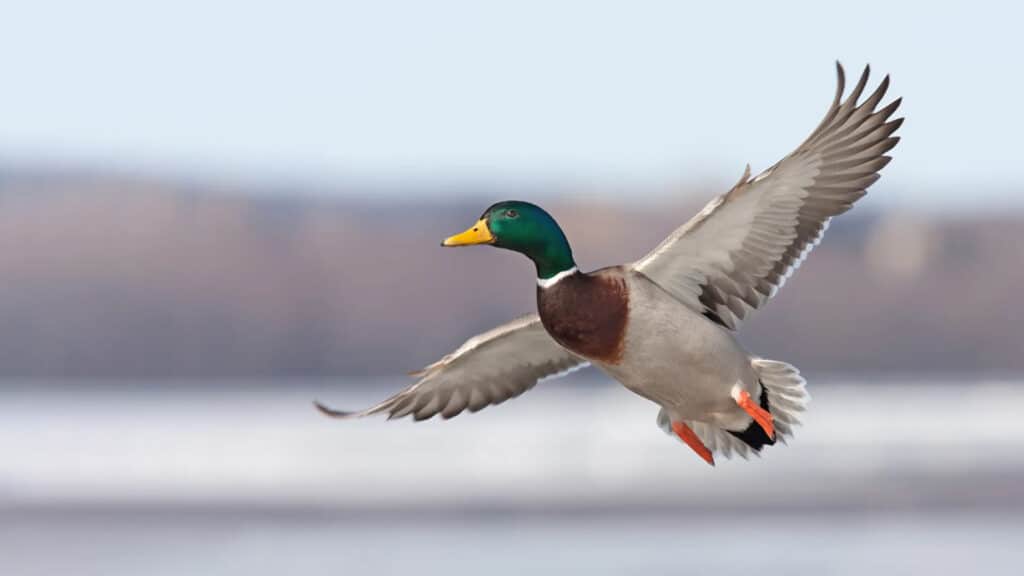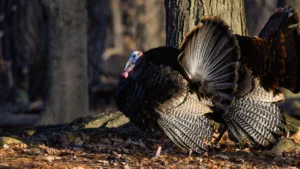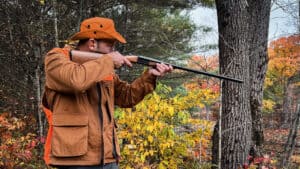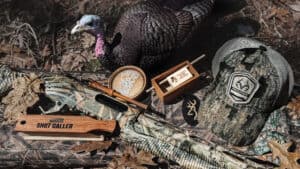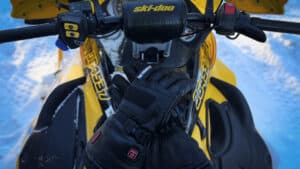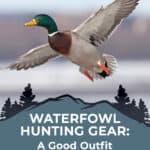Yes. Finally… the bird season is back! And before you even think it, we all know everyone is after the coveted deer season. Even schools in rural areas start discussing plans for the deer season as soon as the kids return in September. But if you haven’t tried birding, then you don’t know what you’re missing! It’s fast-paced, fun, and nowhere near demanding on a hunter’s skillset. All you need are some essential waterfowl hunting gear before you head out, and this post is here to help.
Discloure: Posts may contain affiliate links. Purchases made through our links result in a small commission to us at no charge to you. We only recommend products that meet our brand standards based on testing and first hand use by our authors.
Shotgun Shells for Waterfowl Hunting

Last year, there was an ammo shortage – call it a crisis if it’s the day before you are booked to go hunting and can’t get shells. Been there, done that, and it’s not a good feeling whatsoever! That’s why it’s the first item in this post.
As to ammo shortage, I don’t know if things are officially better or worse this year. The gun budget for the year was exhausted some time ago, so we try to stay away from the waterfowl hunting stores:) However, we do see a lot of empty spaces where ammunition is USED to be anytime we are shopping somewhere that happens to sell ammo. Further complicating matters for waterfowl hunting (duck, geese and a few others) is you have to use a “non-toxic” shot by law. That generally means steel. There are alternatives like TSS and Bismuth, but they are costly and difficult to find.
Further Reading: Remington 870 Custom: The Best Shotgun You’ll Ever Find!
Steel Shot for Duck and Goose Hunting
If you are even remotely thinking of waterfowling this season, buy yourself some steel shot. Do it today or tomorrow while you can still get some. You can always use it later, and it’s not like anything is ever getting cheaper nowadays. This morning, a box of steel shot went up by $5 compared to last year from the same store. That’s roughly a 25% increase!
What Shot Size Do I Need to Hunt Geese?
You will see a lot of references to people using a shot size of #2 or BB, which is even larger. The thing with birding is you are trying to hit the bird’s neck. That is a fairly small target. While bigger shot size has more knockdown power, you have a lot fewer pellets at your disposal. A table with shot sizes vs pellet counts is below. We’ll also cover what I use and why shortly.
What Shot Size Do I Need for Duck Hunting?
If you look this up online, it’s all over the map. Winchester has a blog, and they are not only a gun manufacturer, but they also manufacture ammo. They recommend shots #4, 5 or 6 for small ducks and BBs 1, 2, and 3 for large ducks. That is quite the range, not to mention you haven’t the slightest clue what will fly in during your hunt. Aiming for the middle, the #4 shot stands out as the best of both worlds.
Also note that Winchester has T, BBB and BB specified for geese. When duck hunting, most hunters will target geese too, which further complicates which ammo to pack.
Shot Size vs Count
| Shot Size – Largest to Smallest | # of Steel Pellets per Ounce of Shot |
|---|---|
| T | 53 |
| BBB | 61 |
| BB | 72 |
| B | 86 |
| 1 | 103 |
| 2 | 125 |
| 3 | 154 |
| 4 | 192 |
By looking at this table, there are almost 4x as many pellets in a #4 shell vs T.
My Shot Size Preference for Hunting Ducks and Geese
I have never had a problem with shot size #4 for hunting ducks and geese. A goose may need a follow-up shot – but none of them I hit with #4 have ever flown away. Practicing with clays and patterning your gun will put you light years ahead of the game. When hunting, wait for a great shot vs the “ok” ones. I’ve also used #2 with great success when shot size #4 wasn’t available.
What Shell Size to Use for Waterfowl Hunting?
I always used 2 3/4″ shells until this season, as I had no gun capable of shooting the larger shells. There is NO DOUBT that 3″ shells should work even better – it’s just not technically necessary. Admittedly, I bought a few packs of 3″ for this season and may report back later if they are infinitely better.
2 3/4″ shells also happen to work in a vast amount of guns! This makes it easier to share ammo if you are hunting in a group and one of your buddies has an older gun.
For a second, let’s complicate things. Many “waterfowl guns” even come in a 3.5″ version. I can see using 3″ but not 3.5″. If you’ve ever shot 3.5″ shells in a shotgun, you’ll know it kicks both ways! For hunting turkeys over a greater distance, sure. For waterfowl, it’s overkill, at least in my mind.
Update: I put the 3″ shells to good use, and YES, they are amazing! With a #2, 3″ round, I got three geese with one shell! Let’s just say it was the best hunting experience yet for me. How many deer hunters can get multiple deer with one bullet??? You gotta LOVE waterfowl.
Further Reading: How to Start Trap Shooting
Shell Prices in Ontario
Nowadays, a box of shells can range from around $22 – $30, which is still reasonable. There are countless shells out there that run $55 a box and may even have very similar specs to their cheaper counterparts. Unless you are desperate and can’t find shells, there is no need to overspend on shells. There’s always that old guy with the beat-up old gun (and cheap shells) that can outshoot and outhunt the most rigged out and outfitted hunters. Practice makes you better, not price!
Shotgun Choke for Waterfowl Hunting
Remember, with a steel shot, you can only shoot it out of a modified choke or more open than modified. Unlike lead, steel does not compress and unless you want your gun to blow up, watch your choke!
Unfortunately, so many beautiful old shotguns are lying around collecting dust as fixed choke barrels were quite common back in the day, and the full choke was quite popular. It doesn’t mean the gun is trash, it just has no use for the waterfowler in your house.
The other tip we’ll mention here is choke manufacturer. The stock factory chokes that come with guns aren’t very good. I can say mine are ok. The choke on the one gun is nice – it’s a Beretta modified. If you’re looking for great chokes, try Carlson.
What Gun Do I Need for Waterfowl Hunting?
Since we’re on the topic of ammo and chokes, let’s touch on the gun. It seems like everyone I went birding with was sporting a Beretta semi. I was always toting my beat-up, old Remington 870 Wingmaster pump, and it works PERFECTLY fine. It has a Cutts Compensator, which back in the day meant someone cut the barrel (sometimes a factory option) and put on a device that was an old-school iteration of a choke tube system. Luckily, mine came with a modified tube.
Back to the modern Beretta: it’s semi-auto, full camouflage, has screw-in chokes, an actual recoil system, fibre optic sight and so on. My name was all over this mint, used gun, which got traded into the local gun shop. But there is a point to all this. The newer guns can usually run the 3″ and often 3.5″ shells, which opens the door if that steel shot shelf for 2 3/4″ is empty, but the 3″ isn’t.
For the turkey hunting season, which is coming soon, 3″ and up is the recommended shell size and is what you should be using. In last year’s search for ammo, there were tons of turkey shot sizes available in 3″, but NOTHING in 2 3/4″. You can’t get a turkey with slugs or bird shot – it is neither wise nor legal. With a modern gun, ALL your ammo woes are solved for all your hunting needs, not just waterfowl.
One Shotgun is All You Need
With screw-in chokes, one shotgun can do many different things. Something like the Beretta can truly be the only shotgun you’ll ever need. Also worth a look is Benelli and Browning.
We haven’t done the semi-auto action any justice yet. While pumps can be quick and semis are a “false sense of security”, semis do make a worldly difference with recoil. The action absorbs a lot of that felt recoil you get off the pump or break action, especially with gas-driven semis. If you happen to have a great day with lots of geese or ducks flying in, your shoulders will thank you the next day if you tote a modern gun. It is not just a comfort issue, but it keeps the door open to a 12 gauge for someone with lesser physical abilities, injuries, age or whatever the case may be. Accuracy will also improve as we are taking the flinch out of the equation.
Grandpa’s old shotgun may be nostalgic or cool. Maybe it even took a lot of birds back in the day. But a gratifying new shotgun will take your waterfowl hunting (or any hunting) to the next level. It’s an investment, so to speak and of all the things involved in waterfowl hunting gear, it’s where I suggest dumping a bulk of the budget. It’s a costly mistake to fix later.
Further Reading: A Guided Duck Hunt: The Easy Way to Learn Hunting
What Do You Wear for Waterfowl Hunting?
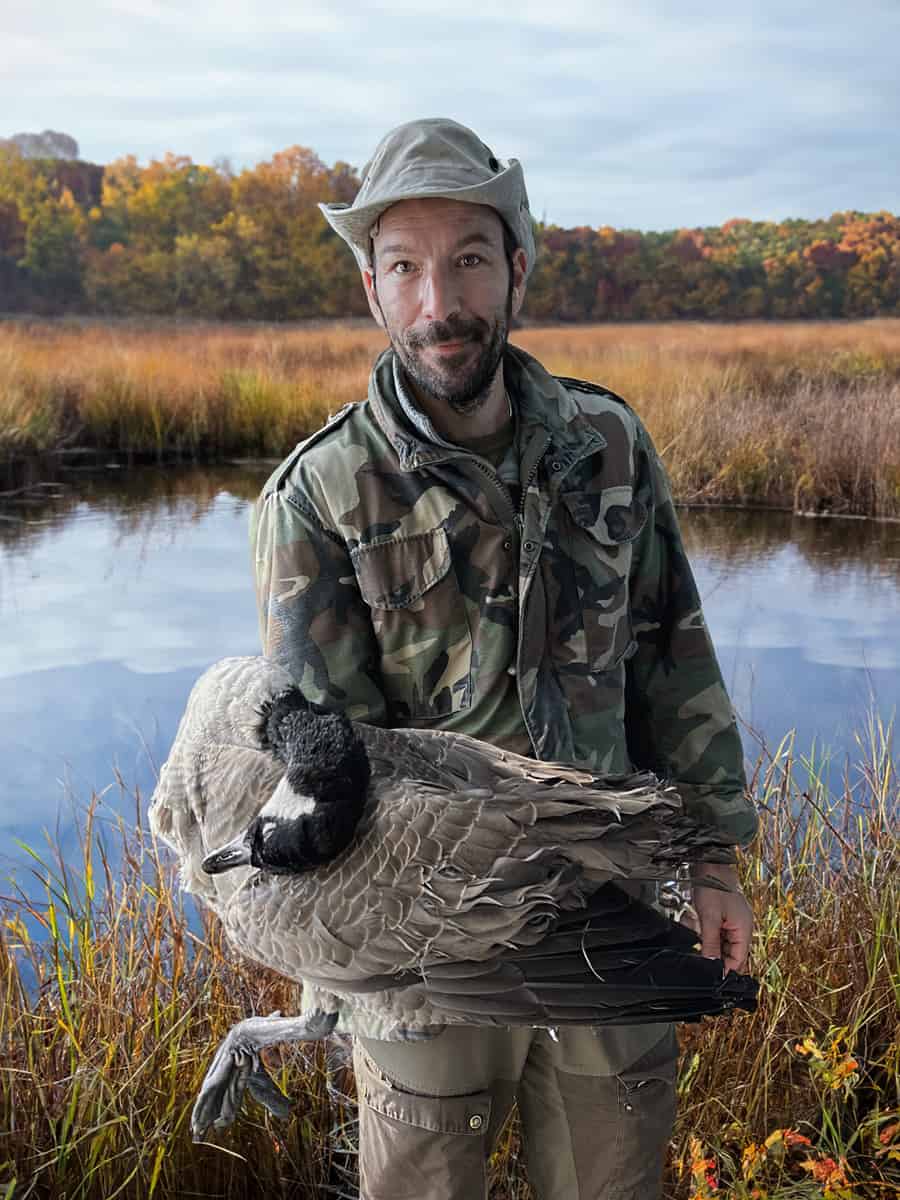
An obvious reminder is to wear clothing appropriate for the weather. Hunting in the rain or dreaded cold is not fun when underdressed.
Waterfowl hunting clothes can get expensive, and if you’re starting, you may not want to spend over $1,000 on duck hunting clothing. An alternative is to invest in some camo hunting clothes. I use army surplus as much as possible. It’s of great quality and durability. When you compare surplus to other hunting brands, you’ll quickly note it’s very budget-friendly. It’s often a fraction of the price. The geese don’t care about any fancy brand label. Work on blending in with the surroundings.
If your budget for waterfowl hunting clothing is razor thin, you can get away with wearing brown pants and a camo jacket. Remember that your hunting accessories should also be neutral in colour (browns, greens and blacks). Unfortunately, you will need to work a little harder to conceal yourself amongst some cover.
If you are into the turkey hunting season, which starts a little later than waterfowl, camo is far more critical than the other birds. If you are not using a blind for turkey hunting, you must cover your neck, face, hands, etc. You’ll generally want to avoid any shine. We’ll cover that in a later post. The bottom line is you can start hunting now with a jacket, maybe some pants and layer the other pieces later.
Hunting Boots and Waders
Boots are a pivotal piece of waterfowl hunting gear, especially this time of year when things start getting rainy and cold. I love my Irish Setters. They are exceptionally durable, warm and waterproof. You can save on waterfowl hunting clothes and allocate your budget to getting a really great pair of boots. Your boots should be able to take a beating and still keep you warm and dry. If you walk some waterlogged trails in the fall, you’ll quickly see what I mean.
There is also a good chance you’ll need waders. You may end up hunting in ponds, or even if on a shallow shore of a lake or river, you’ll probably need to get in to get your decoys out or adjusted. When I went hunting last fall with a hunting guide, we launched the boat at a launch that had no dock! That means at least one person has to get in the water to deal with the hunting boat.
My hunting guide from last fall is in the water every day this time of year – right up until Christmas. After years of doing this, his advice is that all waders start to leak and eventually get torn. Unless the hunting waders have a decent warranty, don’t go overboard on price. Do look for insulated waders, as they will keep you much warmer. The waders that the guide wore were neoprene and in a perfect Realtree Max 5 camo pattern.
What Decoys and Calls Do I Need to Hunt Waterfowl?
First up on the list of duck hunting equipment are calls. It wouldn’t be hunting if you didn’t have to lure in your prey somehow. You will need duck/goose decoys and calls. They are a pivotal piece of your waterfowl hunting gear arsenal. The duck/goose calls are not expensive nor hard to find. But that’s certainly not the case when it comes to decoys.
Hunting Decoys
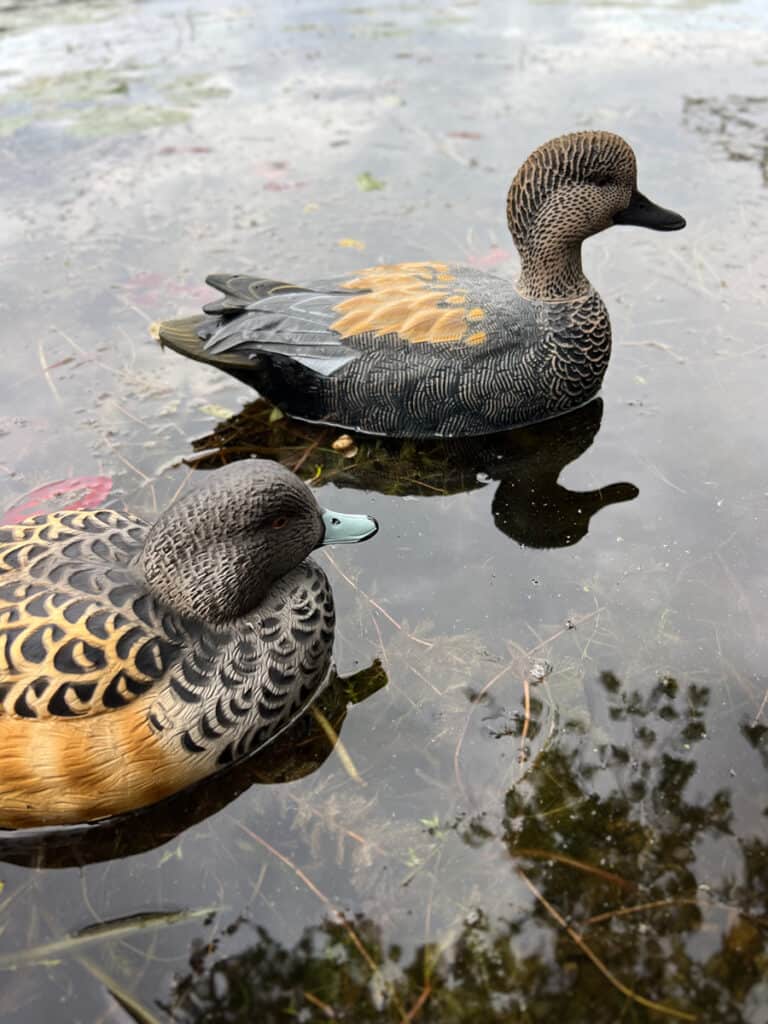
The minimum number of decoys for waterfowl hunting is typically a dozen. Ideally, you would want 18 to 36.
I scored a brand new 6-pack of premium duck decoys last year for $110, which was a great price. If you can find a similar deal, I would suggest it wholeheartedly. Used, they are generally still expensive, but every so often, a good deal will come up on Kijiji or Facebook Marketplace. For example, I bought used goose decoys for $100 for six floaters, which is perfect. Just be warned – good deals on used decoys move quickly, so don’t take too long if you find something that is right for you.
Right now, every hunting store seems to have no goose decoys, at least not floaters. It has the vibe of another shortage item. In Ontario, when in stock, Canadian Tire sells them for $37.99 a piece, or you can try your luck at a Cabela’s/BassPro. As to ducks, there’s the Flambeau Classic Mallard Floaters in a six-pack.
Further Reading: Top 8 Wicked New Turkey Hunting Gear For 2024
Mix it Up
The six-pack of duck decoys I bought is of a nice mix. 2 each of the wigeon, pintail and gadwall ducks. Buy two of each, 1 being a drake and the other a hen. In terms of goose, mix it up if the option is there. Try to get some decoys that are resting, some that are feeding, etc. The intent is to make your spread look as realistic as possible.
When I look back on the photos from my guided goose hunt, my guide did not have mixed goose decoys, and we did perfectly fine. Don’t sweat it if it’s not an option as in times like these, you may have to take what you can get. Mixing them is always better, as it’s more realistic.
Tying the Waterfowling Decoys All Together
I bought a roll of #36 bank line (Ie. tarred mariners bank line) on Amazon. It was 500 feet of SGT Knots 1 LB Spool for under $30. We use this bank line to make a rapid deploy ridge line system for tarp shelters. The bank line has to connect via Prussik knot to a paracord ridge line. A fascinating system ideal for campers, survivalists, and bushcrafters. It comes up here because it’s excellent for tying up waterfowling decoys! You can add a weight to each decoy, run a Texas rig (Ie. 4 decoys per anchor) or tie them all together on a long lake line so they don’t float away on you.
Most hunting stores don’t seem to sell the actual decoy line, which is just a heavy fishing line. Nor do they sell the crimps, weights and other related hardware pieces to “properly” rig your decoys. With a bank line, it’s super easy to tie loops on the ends. You can find carabiners in any outdoor store, and using a Texas rig reduces the number of weights you’ll need. Fishing stores should carry heavy weights. It’s perfect if you opt to rig each decoy separately, and it should suffice for Texas rigs. As to a long lake line, a small boat anchor is all you need on one end, with enough rope between the weight and your first decoy to cover your intended water depth. The anchor I use is 6″ long and 1.5 lb.
To sum up your rigging your decoys, you can easily get away with a bank line, carabiners/clips and some weights. Your rigging doesn’t have to be fancy – it just has to keep your decoys in place and stop them from floating away.
Decoy Bag
Another piece of waterfowl hunting gear to look at is the decoy bag. There are thoughtful decoy bags with compartments for each decoy – this keeps them tidy and ready for transport and deployment. It also allows them to aerate and dry when not in use, not to mention it stops them from banging into each other during transport and storage. Do you need a decoy bag to hunt? No. Is it nice to have? Absolutely yes. If it’s in budget, grab it if you come across one. If not, save this one for later and aspire towards it, as you can get away without it for now.
Calls for Duck and Geese
Duck and Goose calls, a much-needed waterfowl hunting gear piece. Super fun, especially when you are new to hunting. When I purchased my first duck and goose calls, I would mess with the birds in the off-season right in my backyard. It’s amazing how much attention the calls get. You can also sneak in some practice before your actual duck hunt.
Primos makes some fantastic calls. All you need is one call for geese and 1 for ducks. Their standard goose call is the Honky Tonk. As to ducks, a mallard call is pretty generic. I purchased the Primos Pro Mallard to complement an old Lohman call for under $20. You don’t need the fancy wood or acrylic calls to start. That’s something you can always scoop up if you get into waterfowling later.
With the same advice for patterning guns and ammo, you need to practice using the calls. There are numerous YouTube videos on how to use the actual calls. It will also give you a good reference point on what you should sound like. You can get video instructions straight from Primos, as they also have a YouTube channel.
Call Lanyard
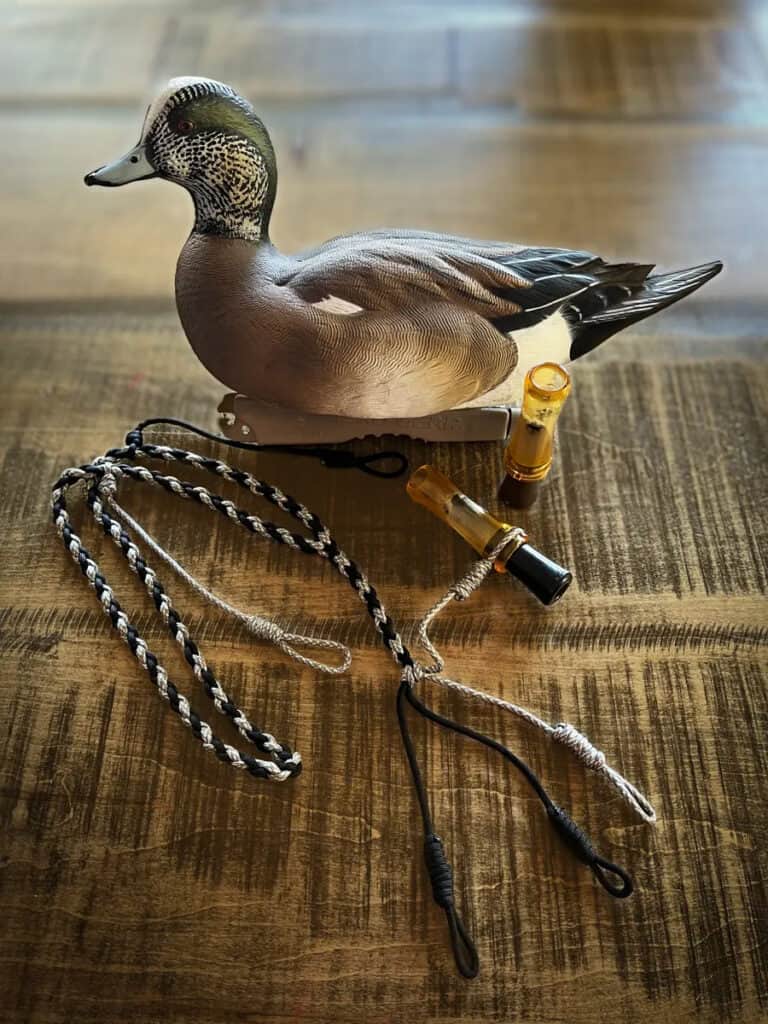
Another worthy duck-hunting gadget is the call lanyard, which is a practical waterfowl hunting accessory. These call holders/lanyards are amazing and are usually made of paracord. The cinch knots on them securely go around all your calls, and its necklace format keeps them at the ready. After calling in your birds, you let go of your call and reach for your gun – much more convenient than trying to pocket your calls.
Pictured is just one of the few I own. The make of the lanyard is not branded and has since been forgotten, but for your convenience, here’s a link to a Duck Call Lanyard.
Migratory Game Bird Hunting License
DO NOT forget your license! I always ensure the small game hunting license is renewed yearly, and it’s usually around Christmas to not forget. Provincial licensing is always one part of the equation, and the Ontario migratory bird license is handled through huntandfishontario.com
Waterfowl licensing is federal, which can also be done online. It’s bought annually but doesn’t follow a calendar year, which is why we say don’t forget to check your license!
You’ll also want one of these, a license holder. It keeps the water out and protects your tags for your other hunting adventures. They are super inexpensive, and you may even get one free if you spend enough money (Ie. New Beretta) at a hunting shop.
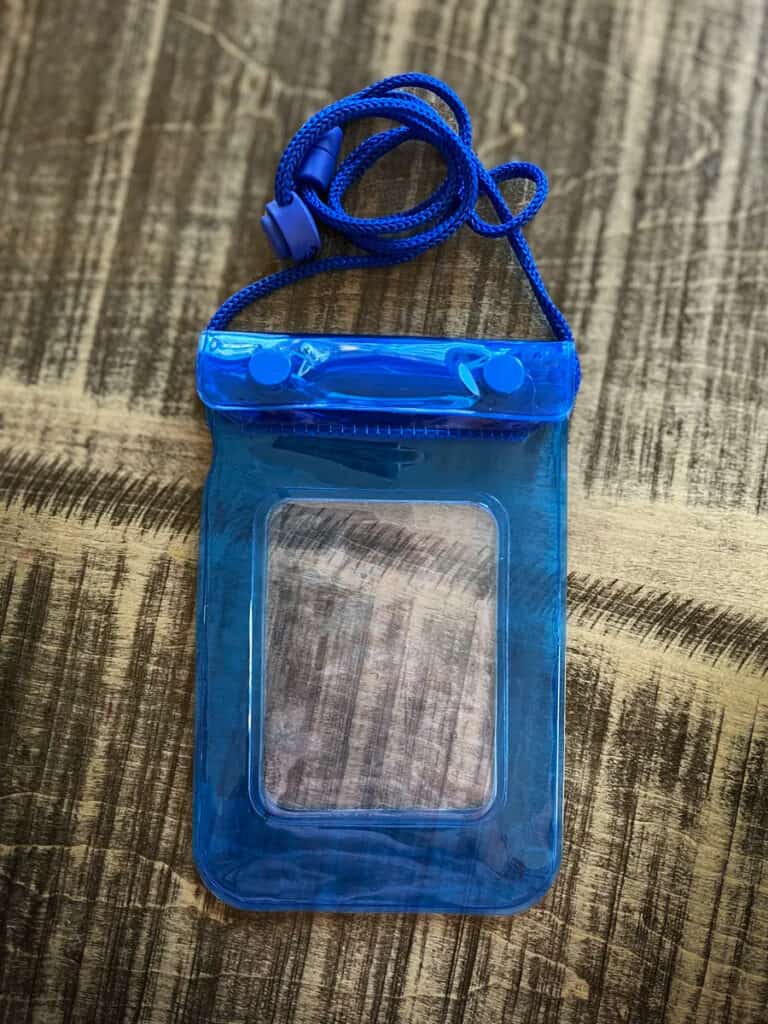
Double-check your firearms license as well. You don’t want to be hunting with an expired one, and if you are six months away from renewal, you may want to renew NOW. Last I checked, they still had some serious backlogs at the RCMP. They were offering a grace period for the delay Ie. they don’t take your guns away if your license is expired but in renewal. However, if you read carefully, you won’t be hunting unless your license is perfectly valid. I believe your guns don’t get to leave the locker, either. You are in a limbo where you are licensed, but you aren’t, if that makes any sense.
Waterfowl Hunting Gear List
Here is a recap of the waterfowl hunting gear you will need to get you started:
- Shotgun and shells
- Modified choke
- Camo clothing
- Hunting boots and waders
- Duck and/or goose decoys
- #36 Bank line
- Decoy bag
- Calls and a call lanyard
- License holder
A Great Resource for Waterfowl Hunters
Ducks Unlimited is another worthy mention here. It is a wetland conservation group started by hunters. Hunters are highly connected to this group today and are major funding contributors. You simply can’t talk waterfowl without the words “Ducks Unlimited” coming to mind. It’s a phenomenal resource for hunters and conservationists alike.
Waterfowl Hunting Gear
So, there you have it! With the right gear and a little bit of practice, you’ll be ready to hit the fields and bag some wild geese and ducks. It may seem daunting at first, but don’t let that deter you. Start with duck hunting if you’re on a budget, and work your way up. Remember, this is a sport that can be enjoyed for years to come, and once you’ve invested in the basics, it’s not an expensive one. So grab your gear and get ready to experience the thrill of waterfowl hunting!
If you found this post useful, please consider sharing. Thank you!
Bookmark this post on Pinterest for future reference!


